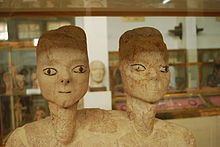Jordan National Museum
The Jordan Museum (English Jordan Museum ; Arabic متحف الأردن, DMG Matḥaf al-Urdunn ) is the largest museum in Jordan . It is located in the Ras al-Ein district of Amman and is home to the most important archaeological finds in the country.

The museum opened in 2014. It has a library, reading rooms, a conservation department and an area for children and young people.
Modern Jordan
The Modern Jordan Department represents the history of Jordan from the Nahda movement through the establishment of the emirate and kingdom to the present day. The exhibition presents the development of modern Jordan with a view to the mandate period, independence, education, health, social life and other aspects of contemporary Jordan.
Living story
The section on Jordan's Living History provides insights into urban, rural and Bedouin ways of life. It aims to connect today's Jordanian youth with their historical heritage, highlighting the diverse cultures of Jordan and the eco-friendly traditional techniques. The exhibition houses elements from the following Jordanian cultures:
- The culture of the desert (Bedu) is represented by a Bedouin tent in the outdoor area of the museum.
- The culture of the villages is represented by a village house.
- The culture of the cities is represented by three city shops.
The collection shows objects of daily life from the nineteenth and early twentieth centuries, for example traditional costumes from the various regions in Jordan or utensils for preparing food, bread and coffee.
Archaeological Department
The largest section in the museum represents the history and culture of Jordan from the Stone Age to the Islamic eras including the Raschids and the Ottoman Empire .
The exhibition includes, among other things:
- archaeological artifacts on loan from the Department of Antiquities (DoA).
- one-to-one reconstructions of some important elements from various archaeological sites, such as a sugar mill from the Jordan Valley and the gate of Ayla (first Islamic city near today's Akaba)
- interactive devices and films on selected topics such as the Umayyad desert castles and the Hejaz Railway .
The collections contain everyday objects such as flint, glass, metal or ceramic vessels as well as statues, jewelry and other art objects.
The outstanding exhibits of the museum include the Ain Ghazal statues, which are among the oldest evidence of human culture of this type, a copy of the Mesha stele, as well as four sarcophagi from the Iron Age and some of the Dead Sea Scrolls , including the copper scroll from Qumran .
Until 2014, some of the exhibits were on view in the Archaeological Museum in Amman.
Web links
- The Jordan Museum Official Website
Remarks
Coordinates: 31 ° 56 ′ 44.3 " N , 35 ° 55 ′ 35.5" E

